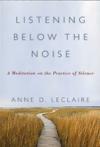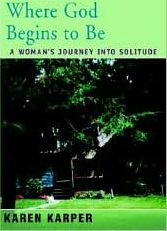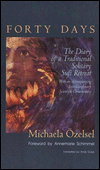Women & Solitude: 17 BOOKS & 1 ARTICLE
Kirsten MacLeod
Sara Maitland
May Sarton
Doris Grumbach
Anne Le Claire
Elizabeth von Arnim
Alix Kates Shulman
Stephanie Mills
Anne LaBastille
Margaret Roach
Barbara J. Scot
Annie Dillard
Karen Karper
Pinions
Jane Dobisz
Michaela M. Ozelsel
Leslie A. Miller
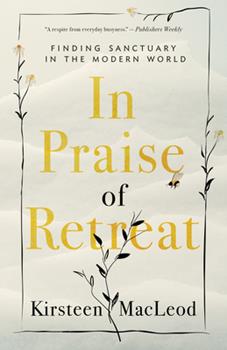 In Praise of Retreat, by Kirsteen MacLeod. Toronto: ECW Press, 2021.
In Praise of Retreat, by Kirsteen MacLeod. Toronto: ECW Press, 2021.
Kirsteen MacLeod’s search for modern retreat takes her – and the reader – on a journey around the world, often identifying traditional retreat sources secularized and adapted to modern sensibilities. The quest enumerates for new travelers names otherwise familiar to the inveterate pilgrim or quiet bibliophile. Less familiar names of sites,venues,and pilgrimages give the reader a chance to experience retreat vicariously. Through the author's sensitive perceptions and clear-eyed judgment emerges a conclusion that the best retreat is the traditional retreat adapted to one’s own spiritual and psychologial inclinations, often without intermediary. Perhaps modern venues are just not worth the effort, each calling for lots of tinkering and rescue. The farther one travels the less one knows.
The first section of five in the book starts logically with something that works: a forest retreat in a cabin that the author and her husband own and occupy in their "green cathedral." That is the positive first experience, but intrusive neighbors with nasty habits ("ATVs in the sanctuary") are a rude awakening. At the same time these incidents prompt the author on her quest for better alternatives. The alternatives tend to fall into three categories: "The Old Ways: Of Hermit Caves, Monasteries and Pilgrim Paths," "The New Deities: Nature and Culture: Of Forest Cabins, National Parks and Creative Sactuaries," and "Light of the East: Of Yoga Ashrams, Meditation Halls, and Body as Temple." Hence, the trajectories of Western, nature, and Eastern traditions, in new and modern reincarnations. The author holds to no particular school and presents the relevance of each category to modern interests, taking the reader from Scottish haunts to Canadian conversions of religious buildings into modern retreats, to ideal settings of forest bathing, to personal disasters with an Indian meditation retreat. Along the way are sprinkles of familiar and new names for exploring retreat on one's own terms, from Oliver Sacks to Thomas Merton, from Diogenes to Karen Armstrong, from Sara Maitland to Rebecca Solnit, from Yogananda to H. D. Thoreau, from Rachael Carson to Mary Oliver, John Muir, and Leonard Cohen.
The disparate thoughts come nicely together to reassure the reader that retreat is possible, even necessary, and that it can be crafted from one’s own sensibilities, here and now.
reviewed 2022 ¶
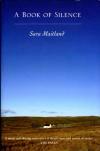 A
Book of Silence, by Sara Maitland. London: Granta, 2008;
Berkeley: Counterpoint, 2009.
A
Book of Silence, by Sara Maitland. London: Granta, 2008;
Berkeley: Counterpoint, 2009.
Sara Maitland skillfully weaves a history of silence and solitude over the centuries with an autobiographical account of her own encounters with silence at her Weardale home, on the Scottish isle of Skye, in the Egyptian desert of St. Anthony, and in the isolated moors of southwestern Scotland where she finally settles. The work is honest, intense, and humane. Maitland's grasp of the subject and its literature, and her own observations of herself and her environs in silence and solitude are fresh and compelling. Maitland writes clearly and engagingly. Plus bibliographical notes and an index make rereading and further exploration easy. A Book of Silence is bound to be a hallmark on the subject.
The book opens with a summary of Maitland's own London and Oxford University upbringing, her mix of intellect, feminism, literary creativity, and religious sentiment. She sets the tone of the book as an adventure on which the reader will want to accompany the author:
In the summer of 2000 I moved north to County Durham, to a house on a moor high about Weardale. I was eager and greedy. I wanted both to be silent and to think about silence. I set out to hunt silence and I have been doing so ever since.
Weardale (in Northumbria, England) becomes Maitland's base camp for the subsequent explorations. Chapter 2, "Forty Days and Forty Nights," describes her stay on the Scottish isle of Skye. Amidst the natural grandeur and silence, Maitland records life in fascinating detail, highlighted by reflections on voice-hearing in natural sounds, changing bodily sensations, and chronicles of solitary mountaineers and sailors. Maitland pays careful attention to the phenomena of silence itself, and how solitude elicits "an extraordinary rhythmical sequence of emotions."
Chapter 3 is "The Dark Side," that is, the psychological side of silence, the reality of surviving in a harsh environment, and accidie, the spiritual lethargy that attacks hermits. Chapter 4, "Silence and the Gods," discusses creation myths from Genesis to the Big Bang. Where non-Western stories see creation evolve from silence, Western myths insist on a loud noise that shatters the nothingness. The initial bang has evolved to noise pollution in the modern world. Western insistence on logos as word pits silence, dreams, and mystery against language, psychology, and meaning.
In Chapter 5, "Silent Places," Maitland notes how exploring silence heightens attention to nature and detail: clouds, birds, stars, wind. She learns to distinguish birds along shorelines and near islands, appreciating the feat of intrepid Celtic monks of antiquity who set out on dangerous seas in tiny boats. Maitland contrasts the evocation of the sea with forests, always historical sources of primordial fear, of Freud's heimlich unheimlich, the uncanny. From here Maitland ranges to fairy tales, linguistics, and the politics of silence.
Chapter 6 is "Desert Hermits," recording Maitland's journey to Sinai for a desert retreat. She writes chiefly of the desert hermits and their spirituality. Chapter 7 is "The Bliss of Solitude." In the desert, Maitland had sought the silence of self-effacement. In chapter 7, she pursues solitude as formative to expression, for she wonders where her creative skill (writing) will next take her given her desire for silence. Inspired by the English Romantics, Maitland pursues walking and climbing in Galloway (southwestern Scotland).
Maitland's forte is her discussion of the Romantic movement. She owns that "on my Galloway walks I took not The Sayings of the Desert Fathers but Wordsworth's Prelude." She notes how older eremitic views of silence emphasize emptying, while the Romantics used silence and nature to strengthen the ego against society. The sad history of the Highlands enclosures, however, shows how fragile is culture's hold on silence and well-being. Maitland is left unresolved, wanting to be both a "silence dweller" and a "silence writer."
In the final chapter, "Coming Home," the author buys an old shepherd's cottage in Galloway. She settles on an 80/20 silence, plugging into phone and internet 20% of the time, doing away with appliances that make noise, praying and meditating 3 hours daily, descending into a composite silence based on experiences related in the book. The fiction writer in Maitland wants to find new expression, while enjoying all of wild nature and the silence. "I am finding it hard to finish this book, because I don't feel that I am at the end of anything," Maitland concludes.
Nor will the reader want to finish the book, either, without hope of a sequel some years hence.
reviewed 2010 ¶
Journal
of a Solitude, by May Sarton. New York: Norton, 1973.
May Sarton is an important figure among American women writers and feminists, and her Journal of a Solitude is considered a turning point not only in her career but in terms of its influence on the structure and content of similar journals, most obvious being Grumbach and Shulman reviewed below. But the notion of solitude in Sarton is a deliberate polemical one: the woman as solitary and marginalized in society and culture. The Journal reflects a year in Sarton's late fifties, living alone in Nelson, New Hampshire, where she moved from Cambridge, Massachusetts after her parents' death. Nelson is solitary as in the sense of small town, but also socially and culturally isolated. But that is how Sarton identifies herself at this stage in her career and life.
I am bored with my life here at present. There is not enough nourishment in it. There are times when the lack of any good conversation, theatre, concerts, art museums around here -- cultured life -- creates a vacuum of boredom.
However, we (and she) know that the isolation Sarton experiences is built into her life as a writer, feminist, lesbian, single child, alone, a person disposed to deep depression and outbursts of anger ("cosmic mood-swing"). "Solitude here is my life. I have chosen it and had better go on making as great riches as possible out of despair," she writes. She is passionately devoted to gardening, flower-arrangements, productivity. Her solitude nevertheless takes her around the country for presentations and poetry readings, and she entertains visitors regularly, who, however, make her feel "overcharged," "scattered." Hence, while the Journal of a Solitude is best viewed as an autobiographical literary work, we can see glimpses of the failed notion of solitude, of the sad and oppressive view of solitude that most people imagine.
reviewed 2002 ¶
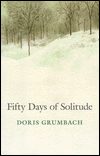 Fifty
Days of Solitude, by Doris Grumbach. Boston: Beacon Press,
1995.
Fifty
Days of Solitude, by Doris Grumbach. Boston: Beacon Press,
1995.
Doris Grumbach was an established writer and 75 years old when she had the opportunity one Maine winter to find herself alone for fifty days. Solitude is never complete: she visited the grocer and post office, attended church services in her little town of Sargentsville, but she elected to exchange a minimum of words and deliberately did not interrelate with anyone.
Rather than boring minutiae, however, her record of these days reveals a sharp mind attentive to detail and introspection. Grumbach has the skill and command of literature to summon up anecdotes and telling quotations running from Jessamyn West to Paul Valery to Henri Nouwen to illustrate her thoughts. This informed, intellectual but humane voice is the strength of the book and makes the whole experiment in solitude worthwhile. Look for no particular psychology or revealing daily journal, just a literate and sensitive record of one person's thoughts at large.
reviewed 2003 ¶
LeClaire is a writer of modest domestic novels. Her non-fiction book echoes the projects of Sarton and Grumbach, but is sprinkled with quotations on silence probably added after the basics were composed. As the subtitle suggests, the work is a personal reflection, and its tone is gentle and humane. LeClaire tells that her favorite childhood book was Frances Hodgson Burnett's The Secret Garden, that she had always looked for an equivalent, but life tended to overwhelm the search.
Like too many of us, I mistook a busy life for a rich one. ... And then in midlife, and quite unexpectedly, I discovered my own hidden garden. Seventeen years ago, on a January afternoon in 1992, I stopped. Simply that. I set aside one day for silence and for twenty-four hours I did not speak. At that time I had no idea this would be the beginning of a personal odyssey of exploration and discovery, a long journey not without difficulties but one that, in the ensuing years, would transform my life.
LeClaire marches serendipitously into silence: every other Monday as a "day of silence," of not talking. A chronology of life unfolds thereafter, revolving around her practice, recounting anecdotes of reactions from husband, grown children, friends, contacts, etc. Writers can always demand solitude for themselves, but LeClaire's practice was not alone time.
In fact we never really fathom what her practice yields or what her motive was. Is it personality, psychology, religious practice? Only towards the end of her narrative of 17 years of silence practice does LeClaire suggest spirituality as a motive, but the statement seems an afterthought without details. Is she repressing something that is worked out in her fictional characters (the content of her writing is never mentioned either)? Is she dissatisfied with anything in particular? Apparently not. Granted that her strong self-confidence and discipline lets her pursue the silence practice despite skepticism from everyone around her, but it is never taken to a higher level of functionality or depth, never coupled with a philosophy, tradition, or methodology.
Perhaps that is LeClaire's modest message: the need for silence is intuitive, and the benefits are positive but elude description. That will satisfy the novice, perhaps. Since publication of the book, LeClaire has been successful on the "women's spirituality" circuit, even giving workshops on silence.
reviewed 2010 ¶
 The Sollitary Summer, by Eliabeth
von Arnim. London: Macmillan, 1899, and reprints.
The Sollitary Summer, by Eliabeth
von Arnim. London: Macmillan, 1899, and reprints.
The initial attraction of The Solitary Summer is the intriguing title, although the chapter titles run from May to September and the first three months are the author's clear favorites. Elizabeth von Arnim (1866-1941) was Australian by birth, English by upbringing, and wrote pseudonymously as a German residing with her German husband, a count, in Pomerania. Her first book was the fictionalized Elizabeth and Her German Garden; The Solitary Summer is a sequel that reflects the writer's intense desire for solitude linked to the haven of her garden, brilliant with flowers assembled by her own deft eye and hand, and nestled on a busy country estate. As the author writes from the opening lines:
I want to be alone for a whole summer,
and get to the very dregs of life. I want to be a idle as I can, so
that my soul may have time to grow. ... I shall spend the months in the
garden, and on the plain, and in the forests. ... I shall be
perpetually happy, because there will be no one to worry me. Out there
on the plain there is silence, and where there is silence I have
discovered there is peace.
Arnim must attend to
three very young daughters, navigate a stuffy husband, and oversee an
enormous household of servants, but she is determined to eliminate
visitors, watch her children and their tutors, strictly manage the
gardeners, and steal solitude in odd hours with resources like Wordsworth and
Thoreau, always with an appreciative eye and spirit for nature.
Descriptions of the grand flower garden dominate the narrative, and
the reader who also gardens is better set to enjoy the author's wit and
observations. As for books and reading, von Arnim takes Thoreau to a sunny pond, Keats and
Spenser to the seashore. Of Thoreau she writes:
Here is a person who loves the open air, and will refuse to give you much pleasure if you try to read him amid the pomp and circumstance of upholstery; but out in the sun, and especially by this pond, he is delightful, and we spend the happiest hours together ...
So runs the prose of this elegant little book, though by the end of
three months of run-ins with stubborn peasants, willful pastors, and
the autumn billeting of a military unit in the von Arnim chateau, the
peace and solitude of the author's expectations is thoroughy disrupted.
By then, though, Elizabeth and the readers have savoredthe solitude of summer.
reviewed 2016 ¶
Drinking the Rain, by Alix Kates Shulman. New York: Farrar, Straus and Giroux, 1995.
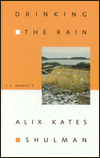 Subtitled "A Memoir" on the dust jacket cover,
this book is a
wide-ranging narrative of a couple of years in the mid-1980's in the
life of a well-known writer and Manhattanite spending summers in an
isolated Maine waterfront cabin. The three sections, The Island, The
Mainland, and The World, hover around the paradox of a passage from
James Baldwin which the author quotes twice:
Subtitled "A Memoir" on the dust jacket cover,
this book is a
wide-ranging narrative of a couple of years in the mid-1980's in the
life of a well-known writer and Manhattanite spending summers in an
isolated Maine waterfront cabin. The three sections, The Island, The
Mainland, and The World, hover around the paradox of a passage from
James Baldwin which the author quotes twice:
One would have to hold in the mind forever two ideas, which seem to be in opposition. The first idea was acceptance, the acceptance totally without rancor, of life as it is, and men as they are... in the light of this idea, it goes without saying that injustice is a commonplace... The second idea, of equal power, that one must never in one's own life, accept these injustices as commonplace but must fight them with all one's strength.
This memoir of solitude on a Maine seacoast does not resolve the paradox, more acute given the author's class and hobnobbery among people of relative substance. Section One shines with hope. Her discovery of self-sufficiency in food (foraging daily for wild greens and fruits, daily clams and mussels), simple quarters, basic furnishings, all off the grid, no running water, etc. are ably described and convey an infectious sense of excitement.
But Section 2, with the Mainland as metaphor for her bourgeois lifestyle, plunges us back into the activist world of posturing and false dilemmas, the noise of urbanity and the chatter of chic angst. (Particularly grating is an old friend met at a Thanksgiving feast, who professes Buddhism as "enjoy what you've got" and then raves about the duck pate.) This whole section is exhausting in relating all the contrived issues the author has collected in her life to date, at the age of "five-oh."
The final section is called The World because it does not resolve the original paradox. It is a little more redemptive but by now the reader may be worn out and a little skeptical, especially with the moose roast at the cabin. It's hard to picture a dichotomous Thoreau, though he too did not resolve his own paradox, but unfortunately our author does not even try very hard by the end. The letdown after Section 1 is never remedied; Baldwin's challenge remains.
reviewed 2004 ¶
 Epicurean
Simplicity, by Stephanie Mills. Washington DC: Island Press,
2002.
Epicurean
Simplicity, by Stephanie Mills. Washington DC: Island Press,
2002.
Stephanie Mills is an established environmental writer and lecturer with books, articles, and conference appearances to her credit. In this book, her insights on nature, environmental degradation, and the elements of living simply are clear, articulate, and compelling. But, as Mills tells the reviewer, the book is not explicitly about solitude. It, nevertheless, may serve as a diary of happenstance and a guidebook to the viable solitary.
Epicurean Simplicity shows that a life of solitude is not necessarily deprived of people, emotion, or the sensuous (that is, sense-related) pleasures of nature, hence the notion of benign Epicureanism underlying a simple life observed and savored. Mills offers a very autobiographical narrative of life on 35 wooded acres in northern Michigan -- part diary, part writer's journal, part philosophical musing, plus some nostalgia and speculation. She is sensitive to seasons and circumstances. The sympathetic reader instantly shares the natural wonder and pathos Mills conjures, describing trees, insects, gardens, snow, animal friends. These are the sources that fill our senses with delight and a little pathos, confirming the naturalistic philosophy of Epicurus and Lucretius, who bid us set aside artificial speculations and recognize the exquisite beauty and simple wonders of life and nature before us.
Mills calls herself a Luddite shunning technology, hunkering in her cabin with propane and firewood, attending to her own chores, pursuing the small wonders of natural life at her window or woodlands, a simple life of writing and reflecting. Since publication Mills reluctantly uses a computer and the Internet, in part the result of pressure from editors.
Epicurean Simplicity is not laden with science or scholarship. The tone is conversational, the prose lyrical, the thoughts unflinching. The book is a congenial reflection on the art of living in solitude and simplicity.
reviewed 2006 ¶

Wildlife ecologist, writer, and photographer Anne LaBastille (1933-2011) published four autobiographical books among her dozens of books and articles, Woodswoman being the first. Here she chronicles not so much an overt pursuit of solitude as an exploration of her personal accommodation with nature and people. As an avid naturalist, she built her own log cabin in the Adirondack forest, next to a lake, off the grid, away from roads and human habitation. "Ever since a childhood spent near New York City," she writes, "I had wanted to live in a Thoreau-style cabin in the woods." The motive was compounded by a divorce compelling her to quickly decide what she wanted to do with her unexpected solitude life.
The cabin becomes her physical and psychological sustenance, the embodiment of her solitude:
The cabin is the wellspring, the source, the hub of my existence. It gives me tranquility, a closeness to nature and wildlife, good health and fitness, a sense of security, the opportunity for resourcefullness, reflection, and creative thinking.
From childhood LaBastille's talent was both academic potential and nature. The book recounts intersections with a variety of people in an engaging narrative style, interspersed with adventures in the outdoors. But LaBastille is not a hermit (Noah John Rondeau and other local historical hermits she mentions only as local color); she is not a philosopher (she notes, of a mystery correspondent, that "it seems as if he were looking for a dream person, a recluse, a philosopher.") Her dealings with people always fall short of satisfying. Rather, the reader feels the physicalness of LaBasille's life trajectory, the ease with animals, trees, wind, water, snow, cold. Her circumambulations always return to the cabin. The book's epilog wistfullly summarizes her life in the cabin, as if it alone was permanent in the cycles of life:
Sometimes I sit in my log cabin as in a cocoon, sheltered by swaying spruces from the outside world. From traffic, and noise, and liquor, and triangles, and pollution. Life seems to have no beginning and no ending. Only the steady expansion of trunk and root, the slow pile up of duff and debris, the lap of water before it becomes ice, the patter of raindrops before they return to snowflakes. Then the chirp of a swallow winging over the lake reminds me that ... there is always a new beginning.
reviewed 2011 ¶

And I Shall Have Some Peace There: Trading in the Fast Lane for My Own Dirt Road, by Margaret Roach. New York: Grand Central Publishing, 2011.
Margaret Roach was a career editor at Newsday and Martha Stewart, with every appearance of a consumate Manhattenite -- except for a 1998 book A Way to Garden that suggested something else might be percolating. And I Shall Have Some Peace There tells of a resurrected and unpursued dream of solitary living (as in aloneness, not isolation) in a small Hudson Valley town. Its tone, however, seems out of character given her gardening interest, especially with subsequent publication of The Backyard Parables and the vitality of Roach's gardening blog and busy speaking schedule.
The book is constructed around zany, quirky mishaps and ruminations, with self-deprecating humor on every page, none of it serving to reveal insights about solitary living so much as maintaining the author's apparent sense of insecurity and powerlessness before her fragile past-but-still-present interpersonal relationships, and copings with a ramshackle house, "never alone or lonely, but somewhat betwixt," as she puts it.
I think I am just slightly in shock, the washer drum within me still wanting to agitate but not sure just why, or whether to bother; my inner troublemaker wondering why we aren't doing something. I keep trying to tell it that we are (which perhaps can serve as at least partial explanation of why I talk to myself?) ... If I am neither working nor in a personal partnership, in service to some master or another, who am I?
Many pages later, similar outpourings continue, though along the way Roach has alluded to Joseph Campbell, Jung, Greek myths, Blake, Yeats, Eliot, suggesting a deeper current flowing -- but also quoting pop music lyrics more often. The reader never really finds out about how Roach comprehends solitary or rural living, why she pursued the peace she hopes to attain. But The Backyard Parables and her robust gardening blog may be redemption for or transcendence of this incomplete tale that longs for immersion with nature if only the noisy voices in the author's head can be put away.
reviewed 2013 ¶
The Stations of Still Creek, by Barbara J. Scot. San Francisco, CA: Sierra Club Books, 1999.
 There is more
in this book about marriage
and mountain
climbing than about solitude, though Scot's memoir features a central
image of solitude in self and nature. She and her husband own a cabin
on the outskirts of Mt. Hood National Forest in Oregon, where she
retreats alone after a disturbing experience. Her husband Jim, an avid
mountain climber, is reported missing in an accident in Nepal, and
though soon confirmed to be alright and later back home in one piece,
Scot has suffered an emotional jolt that compels her to revisit her
life's priorities. Jim is the other major character in her tale, whom
she portrays with brutal frankness as aloof and business-like. His safe
return from Nepal has only triggered Scot's quest for self-discovery.
Jim is rehabilitated at the end of the story during a mountain climb
they both undertake -- together, for a change.
There is more
in this book about marriage
and mountain
climbing than about solitude, though Scot's memoir features a central
image of solitude in self and nature. She and her husband own a cabin
on the outskirts of Mt. Hood National Forest in Oregon, where she
retreats alone after a disturbing experience. Her husband Jim, an avid
mountain climber, is reported missing in an accident in Nepal, and
though soon confirmed to be alright and later back home in one piece,
Scot has suffered an emotional jolt that compels her to revisit her
life's priorities. Jim is the other major character in her tale, whom
she portrays with brutal frankness as aloof and business-like. His safe
return from Nepal has only triggered Scot's quest for self-discovery.
Jim is rehabilitated at the end of the story during a mountain climb
they both undertake -- together, for a change.
The stations theme is, of course, reminiscent of the Stations of the Cross, but here they are emotionally positive, natural settings Scot discovers in the forest around the cabin, dubbed Old Growth Sculpture, Burned-out Cedar Snag, Maidenhair Fern Point, Green Cathedral, among others. But Scot never delves into a philosophy of life and solitude. Rather, at this stage of her life (age fifty-four), the experience of the stations touch a feminine chord that sets the author on a path of reflection and reassessment. She is not an idle Thoreau, but is wrestling with mixed feelings about marriage, nurturing, creativity, and death. Her chronicle touches the female pulse of life, the yin of nature. The book shows how solitude can become a very subjective pursuit, such that an outsider can only watch from afar and hope for the best.
reviewed 2006 ¶
Pilgrim at Tinker Creek, by Annie Dillard. New York: Harper, 1974.
 Women
writers in search of solitude or
happening upon it in
reflection interweave a more private persona into their narrative that
is usually absent in the bravado or aloofness of men's writings. But
Dillard comes close to mingling the two genres. She lives alone in the
Blue Ridge Mountains of Virginia and these magazine articles cobbled
into an ostensible pilgrimage in the surroundings of a creek near her
home breathe an unsettled and unsettling ambiguity.
Women
writers in search of solitude or
happening upon it in
reflection interweave a more private persona into their narrative that
is usually absent in the bravado or aloofness of men's writings. But
Dillard comes close to mingling the two genres. She lives alone in the
Blue Ridge Mountains of Virginia and these magazine articles cobbled
into an ostensible pilgrimage in the surroundings of a creek near her
home breathe an unsettled and unsettling ambiguity.
"I am no scientist," Dillard tells us. "I am a wanderer with a background in theology and a penchant for quirky facts." She considers her house in a homely vein: "An anchorite's hermitage is called an anchor-hold; some anchor-holds are simple sheds clamped to the side of a church like a barnacle to a rock. I think of this house clamped to the rock-bottom of the creek itself and it keeps me steadied in the current as an anchor does, facing the stream of light pouring down." She gets the etymology right, but it is entomology that really moves Dillard, with an air of Southern Gothic. Beware the barnacle image! Dillard's view of nature is sheer Darwinian caricature accelerated to the bizarre and macabre. She describes giant water bugs disabling frogs, biting insects bringing down small mammals, the shrewd mechanisms of parasites, muskrat hunting, leeches, ducks frozen on wintry lake surfaces, horrors of locusts. "For most creatures, being parasitized is a way of life -- if you call that living."
Nor is the plant world exempt from Dillard's dark eye: "I see scratched and peeled stems, leaves that are half-eaten, rusted, blighted, blistered, snipped, smutted, pitted, puffed, sawed, bored, and rucked."
Is there a philosophy of life here, let alone one of solitude, harmony, or pilgrimage? Concludes Dillard: "Is this what it's like? I thought then, and think now: a little blood here, a chomp there, and still we live, trampling the grass? Must everything whole be subdued? Here was a new light on the intricate texture of things after the fall: the way we the living are nibbled and nibbling -- not held aloft on a cloud in the air but bumbling pitted and scarred and broken through a frayed and beautiful land." Dillard's frayed soul, left in a macabre solitude, projects itself as a pilgrim in a strange and hostile land.
reviewed 2005 ¶
This is a narrative of several years of life in a West Virginia backwoods, written by a Poor Clare nun experimenting with a new lifestyle. Sister Karen entered her order in 1959 at the age of 17. She was in her twenties when the ramifications of the Second Vatican Council struck her order, as well as the entire Catholic Church. It is not clear if she used the hermit status as a polite way of quitting the order, but it took thirty years to get to the status that was denied a lifetime to Thomas Merton.
For the author of a biography of St. Clare,
this book lacks a
spiritual dimension and the deeper insight that solitude is supposed to
offer to a spiritually-minded person. Much is promised by the title,
which the author derives from a line of Meister Eckhart: "There where
clinging to things ends, there God begins to be." Further, one
hesitates to describe these years as those of a hermit, for it seems
busy with human interrelations: two other nuns living nearby, a
garrulous old neighbor, the grocery, the post office, repairmen,
church, even a monthly return to the Ohio convent to teach. We all have
neighbors who live solitary lives, keep to themselves, pursue a silent
routine of work and chores -- but they are not hermits.
The author acknowledges the lack of personal feelings in her narrative
when several potential publishers critique her manuscript, but the
absence of insights of famous Christian hermits or mystics is telling.
One reviewer, also a nun, unsparingly criticized the author's affection
for her cat as a displaced love of Christ, condemning the book to a
shallow egoism!
The author is now Karen Fredette, married and editor of a newsletter
for hermits, Raven's Bread. One wonders how the
transition from near-hermit and nun to full-time "householder" would
work as a sequel.
reviewed 2004 ¶
This modest 80-page book is the autobiography of an Englishwoman who became an anchoress in the Anglican tradition.
Pinions (her pseudonym) worked for the Women's Auxiliary Air Force of the UK during World War II and afterwards, visiting many countries and seeing may cultures and peoples. During a stint in Algeria, she experienced an insightful moment viewing the Atlas mountains through a haze, a moment when her hatred of God (she had just lost a favorite brother over Germany) melted into a sense of a transcendent God found in nature, and , later, she says, in people and circumstances.
For Pinions was not brought up religious, and her progress was worthily her own. She read the Christian spiritual classics (Cloud of Unknowing, John of the Cross, Ruysbroeck) and, returning to England, sought out a spiritual director. After a couple of meeting he surprised her by suggesting she become a nun. Pinions entered a contemplative community but found the minimum of prayer and the maximum of busywork unsuitable, and left the order after five-plus years.
"It could be that you have a higher vocation, " a new director suggested, and he trained her to become an anchoress. And it worked. Pinions followed a version of the Ancrene Wisse and Rule of St. Benedict, and with the approbation of the local bishop moved to a small cottage or hut. Her life of prayer and solitude blossomed.
Pinions offers a clear and unpretentious description of prayer based on her experience, ascending from meditation and "prayer of quiet" to recollection, contemplation, and intercession. She offers examples from her daily life and sufferings, and several of her own prayers. Her daily life records her reluctant departure from the cottage after nearly ten years due to a serious kidney ailment, finally residing in the separate quarters of a benefactor after long and unhappy stays in the hospital.
Later, largely bedridden, came a chance interview in a religious newspaper, followed by a BBC interview. Correspondence came, from a trickle to thousands of letters from around the world. Pinions happily answers each. Correspondents usually seek a bit of counsel, which, she offers in a spirit of joy, kindness, simplicity, and courage. She would never seek to convert anyone, she writes, and sees the oneness of humanity as the key to understanding Christian virtues.
The life of Pinions reflects a friendlier concept of the anchoress than the austere medieval image of enclosure or cloister. Though she kept her temporary vows as a nun and during her hospital stays would reply to enquiries about what she did that she was a nun, Pinions crafted a new lay (female) religious function in the church, sustaining the anchoritic tradition while offering the spiritually-minded solitary a viable model of life adaptable by her own recommendation to anyone so disposed.
The title comes from a glimpse of a whirling sandstorm during the period when she was to experience a kind of epiphany in Algeria. The cover subtitle to the New York edition is "The Story of a 20th Century Anchoress" and contains a foreword by American writer Annie Dillard.
reviewed 2003 ¶
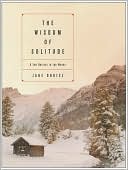 The
Wisdom of Solitude: a Zen Retreat in the Woods, by Jane
Dobisz. New York: HarperSanFrancisco, 2004. Reprinted
as One
Hundred Days of Solitude: Losing
Myself and Finding Grace on a Zen Retreat. Somerville, MA:
Wisdom Publications, 2008.
The
Wisdom of Solitude: a Zen Retreat in the Woods, by Jane
Dobisz. New York: HarperSanFrancisco, 2004. Reprinted
as One
Hundred Days of Solitude: Losing
Myself and Finding Grace on a Zen Retreat. Somerville, MA:
Wisdom Publications, 2008.
The charisma of this little book is the author's amiable assembly of events in her 100-day solitude within the themes of insightful koans and stories of Zen masers. The book is not a rote diary's succession of random thoughts or events but a reflection on a succession of realizations about self and reality, an anecdotal conversation with a person who has acquired a certain wisdom even as we watch.
The details of what the deserted cabin was like, the kind and quantity of food, the sensations of winter and abiding solitude -- plus the routine of sitting, walking, bowing (a vigorous exercise), wood-chopping, all following the instructions of a Korean Zen master, are presented with modest and grace. There is nothing here to frustrate a non-Zen reader or anyone inexperienced with solitude. Dobisz was a novice herself, and so the experiment in solitude as enlightenment is clearly and warmly communicated. She writes:
By making my focus smaller and smaller, everything is getting bigger and bigger. ... There's a vast space around things in which anything is possible. A sense of rapture permeates even the smallest activities of the day. ... The true way is always right in front of you.
Twenty-five years later, Dobisz is now Zen master Bon Yeon leading retreats in the Boston area. URL: http://www.thewisdomofsolitude.com.
reviewed 2006 ¶
Author Ozelsel was born in Germany, grew up mostly in Turkey, and studied at U.S. and German universities, becoming a professional psychotherapist and lecturer. Not only is this first-hand account of a Sufi halvet or retreat unique because it is written by a Muslim woman well versed in Sufi and Islamic literature but also because the author is familiar with scientific methods and psychological foundations. She strengthens her narrative with an appendix of over a dozen brief commentaries.
The retreat transpired in a tiny unfurnished (except for her mattress) Istanbul apartment during a cold winter, with intermittent electricity and water. Her fast paralleled the Ramadan fast but with less food. Ozelsel kept a daily record of her mind and spirit, integrating her sole reading for the retreat: the Quran, Mevlana (i.e., Rumi), and Ibn Arabi, plus her audio cassettes of of ilahi (dialog prayers) and zhikr (repetitions of God's names), the latter functioning like mantras, accompanied by physical movements of head and body.
The details of her solitude range from early despair to tears of joy. Ozelsel carefully monitors thoughts, emotions, and bodily phenomena. She marshals quotations from her reading sources that help structure the insights she relates, as well as informing the reader about the depth of Sufi tradition. The many commentaries on the psychology of ritual, the teacher, the mental and physiological phenomena experienced, and discussions about the functions of the halvet are an informative addition. The book is a unique view of solitude and spirituality, and Ozelsel is an excellent guide, writing with heart-felt intimacy and refreshing honesty.
reviewed 2008 ¶
Solitude has always been problematic for women due to social role and ascribed psychology. Solitude has been a man's privilege, defined by men as a reward for creativity and retreat, like the ebb and flow of battle. The virtue of Miller's essay is to point out the concept of "capital" in men's use or insistence on solitude, versus the aspirations of creative women who stand alone in the "temple of Silence," but find it empty. Here Miller evokes a scene from Turgenev's Fathers and Sons, highlighting the dilemma of the aspiring Anna, who happens upon a statue of Silence, like a female Greek muse, deliberately abandoned (or hidden away) by her late husband in a corner of the estate's barn.
Miller makes some excellent points about solitude and creativity:
As a writer, I can't help noticing that solitude is something some people have more of than others. It must be valuable, a resource. I stress here solitude as an alleged enabling force for the artist, specifically for the writer as artist, solitude as time to read, to ponder, to be distracted, to be "half conscious," inward, even selfish, to write and to have respect from others for the enabling seclusion. In many ways this sort of solitude implies many other conditions as well: for example, economic independence produces leisure time, which in turn produces solitude or the opportunity for it.
Insofar as solitude makes the product (writing) possible, it can also produce power: for example, the production of a book of poems in the field of writing also produces a certain amount of legitimacy or power for the writer, so solitude becomes indirectly linked to power by making it possible. Class may produce solitude by producing economic independence. Gender may also be a factor in the production of solitude; the solitary male poet adds himself to a long and respected tradition of cosmologies and epiphanic moments of solitary communion with nature; the solitary female poet, however, adds herself to a slimmer tradition fraught with suicides, agoraphobia and a seemingly unnatural aversion to bearing children.
Miller notes the advice of (male) poet Rilke to an aspiring young (male) poet, and the parallel advice of poet Robert Bly. Both think of a poet's desired solitude in terms of the privilege of men to assert their need for creativity. On the other hand, women poets, such as Cynthia MacDonald, honestly reflect upon the difficulties of the woman poet, who must tack on creativity to a mundane and circumscribed social role, in contrast to men poets who are free to carve out a profession and pursue their dreamed necessities.
Women poets reflect the dilemmas of their search for solitude. Emily Dickinson saw poetry as just a key turn away from conventional life. Not so facile for others; Miller mentions Adrienne Rich, Anne Sexton, Edna Millay, and Carolyn Kizer as poets of anguish and struggle. French writer Colette is more ingenious, even if obliged to a negative resourcefulness. Miller notes:
Locked in a room by her elderly husband, Willy, to write the Claudine books which he graced with his own name, Colette was forced to create novels. In the process she also created herself and a marketable product that would always ensure her right to the enabling solitude.
Much of Miller's essay describes her attempt to find a situation that would offer solitude and space for her own poetic creativity. She found it in the spare and mundane work of hotel clerking, during which long hours, especially at night in roadside motels, offered plenty of solitude, if not inspiration. Her odd jobs here remind the reader of the hapless women workers in Barbara Ehrenreich's Nickel and Dimed, except that those women had long lost aspiration for creativity -- assuming that society had ever been so kind as to have nurtured that possibility. But Miller scrabbled through the tough, boring hotel jobs and directionless ill-conceived marriage, eventually completing a doctoral degree, wrote several books of poetry, and earned tenure teaching at a university.
At the time of writing this essay, however, nothing like this was certain in Miller's future. She was still at the hotel clerking stage. And she knew what a difficult and solitary course must lie ahead:
To be female and to demand such things as retreat from life and from loved ones is difficult and different. To assert the need for retreat when one is young, a wife and not yet a verified artist seems selfish, stubborn, even crazy. And insisting on such selfishness is hard enough without the guilt that accompanies it even in twentieth century America. In many ways, when a man effects such a retreat, his actions are not only honorable but a kind of "symbolic capital" in that others will respect them, if he is an artist, a "sensitive man" as in the case of Rilke. In this sense it becomes "gender capital," accruing interest for the male, costing the female. The image of the male poet in retreat can be attractive to society. But the image of a female poet in retreat is somehow against nature, a liability that can lead to emotional bankruptcy.
But solitude is both a condition of creativity and a state of spirit, and Miller's dogged pursuit of her aspiration shows what can be done, even if being "alone in the temple" is not just a physical aloneness but an assigned status that must be vigorously denied.
reviewed 2009 ¶

